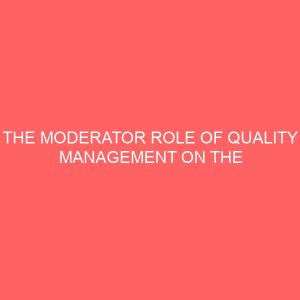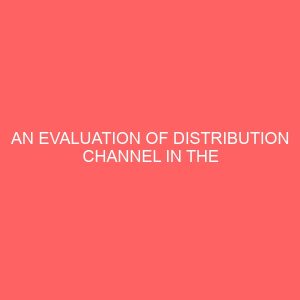Description
ABSTRACT
This research work aimed at investigating the assessment of managing conflict in organization especially that of non-profit making organization. The objective of the study is to provide necessary strategies to manage conflict and to make appropriate recommendation, for effective conflict resolution, and to ensure development, productivity and societal growth. The researcher adopt the description pattern of study and uses personal interview and questionnaires to collect data for the studying sixty questionnaires were distributed to both the senior and junior staff of the Hart/and construction of Nigeria limited Auchi, and the application of Z test was adopted for analyzing the test of hypotheses. The research findings revealed that the causes of conflict are poor communication gap, unequal distribution of rewards, and power tussles among staff. We recommend that collective bargaining, acceptance of subordinate goals, and effective communication device to employee should be adopted by the administrators.
TABLE OF CONTENTS
Title Page i
Approval Page ii
Certification iii
Dedication iv
Acknowledgements v
Abstracts vi
Table of Contents vii
Chapter One: Introduction
1.1 Background of the Study 1
1.2 Statement of Problem 3
1.3 Objective of the study 3
1.4 Research Questions 4
1.5 Statement of Hypotheses 4
1.6 Scope of the Study 5
1.7 Significance of the study 6
1.8 Limitations of the Study 6
1.9 Operational Definition of Terms 7
Chapter Two: Literature Review
2.1 Introduction 8
2.2 The Review 20
2.3 Summary of the Chapter 26
Chapter Three: Research Methods
3.1 Introduction 28
3.2 Research Design 29
3.3 Population of the Study 29
3.4 Sample and Sampling Technique 30
3.5 Instrumentation 30
3.6 Method of Data Collection 31
3.7 Method of Data Analysis 32
Chapter Four: Data Presentation, Analysis And Discussion
4.1 Introduction 35
4.2 Data Presentation and Interpretation 36
4.3 Data Analysis and Hypotheses Testing 37
Chapter Five: Conclusion and Recommendation
5.1 Introduction 48
5.2 Summary of Findings 48
5.3 Conclusion 49
5.4 Recommendations 50
5.5 Suggested Area for Further Studies 51
Reference 52
CHAPTER ONE
INTRODUCTION
1.1 Background of the Study
The study of conflict management as it is aimed in this work is to investigate how conflict can be managed among organization personnel in Hartland Construction Nigerian Limited, here in Auchi head office, and other zonal offices in the federation. Many organizations has faced different conflicts in the organization of both material and personnel, but the ability to manage these conflicts lead to the organizational effectiveness and improve efficiency, but when not properly handled, it results to loss of man hour, waste of resources and low productivity.
Basically, conflict is inevitable in organization. It can be negative or positive in an organization depending on the way it is handled asserted by Mr. Victor Umoru. There is no meaningful development that can take place in a state of rancor and prevailing issues in the world today in general and since it cannot be eliminated entirely and one must live with it, the best attitude on effective and efficient execution should be developed towards it. That suggest that the inevitable in the industrial setting should be recognized and developed and understanding of the ways of managing, minimizing as well as resolving it.
An organizations needs to create a peaceful environment where high degree of compromise and better understanding will be reached between the Administrators, union, employees in civil services where all this exist. There’s always a high degree of productivity and great commitment when provision of welfare services are made that in turn lead to organizational development.
Conflicts in Nigeria organizations are disastrous especially when it is negative, thereby creating unnecessary economic lost to both institutions (Society and the organization). This at times results to industrial action such as strike, lockout, street protest, seat tight, go slow etc which results to loss of production, loss of man hour, and waste of resources. This survey tends and aimed to deal on the conflict management in an organization to ensure organizational developmental efficiency with high productivity to the societal growth (Coser, 2006).
1.2 Statement of Problem
The major focus of this study is to determine the following problems of conflict base on this scenario;
Limited resources
Interdependent work
Communication problems
Difference in perception
Task asymmetric
Unclear authority structure
Different attitude
Individual personal problem
1.3 Objective of the Study
The specific objectives of this study is to:
Determine whether or not non-profit making organization, attach different level of importance to conflict management technique.
Determine the level of concern administrators show to conflict situation.
Determine managerial conflicts strategies that non-profit making organization like to adopt.
Determine the level of impact conflict has in non-profit making organizations.
1.4 Research Questions
a. How significant is collective bargaining to administrators and employee in conflict resolution?
b. To what extent does understanding exist between administrators and employees on a particular conflict situation?
c. What are the causes of conflict in an organization?
d. To what extent has the administrators and employees agreed to conflict control?
e. What are the various method used in reducing conflict in your organization?
1.5 Statement of Hypotheses
Hypothesis One
HO: Collective bargaining does not play significant role in conflict resolution.
HI: Collective bargaining plays significant role in conflict resolution.
Hypothesis Two
HO: Conflict does not enhance good understanding between administers and employees in an organization.
HI: Conflict enhance good understanding between administers and employees in an organization.
Hypothesis Three
HO: Misunderstanding between management and employees does not result to conflict in an organization.
HI: Misunderstanding between management and employees results to conflict in an organization.
1.6 Scope of the Study
This study is operationally restricted to non-profit oriented institutions in Nigeria, especially here in Auchi. Which personal interviews and questionnaires where conducted and administered to both junior and senior staff of Hartland Construction Nigerian Limited, Auchi Edo State Head Office. And the response will be used to make generalization, conclusions and recommendation base on this work.
1.7 Significant of the Study
The significant of this work is mainly expected to be beneficial to organizations’ and administrators’ methods of conflict resolution model, so as to avoid future conflict actions, and by ensuring organizational development are achieved through the use of corrective action of conflict.
Above all, this study will contribute immensely to the wealth of knowledge in the area of management, which will be beneficial to management students, administrators, business men and managers etc. This will obviously increase the efficiency of Business growth and its productivity.
1.8 Limitations of the Study
Basically, the limitation of this work is on the poor response rate by respondent and uncooperative attitude in ensuring that the conduct of the personnel are interviewed.
The personnel are always on patrol, and thereby finding it difficult to see the personnel at due time te interview. The unavailability of funds to procure the necessary materials was difficult. However, the data collected here were used to analyze and generalize the outcome of this research in concluding the bases of the findings on this survey.
Finally, constant frowned attitude of some of respondents at some questions which they felt and ‘think that’ such questions might be probing to their work or office.
1.9 Operational Definition of Terms
Conflict: Conflict is a situation in which people groups or countries involve in a serious disagreement or argument.
Strike: Strike is a work stoppage caused by the mass refusal of employee to work.
Collective bargaining: Collective bargaining is a process whereby representatives of management and workers negotiate over issues like wages, hours and condition of employment.
Go slow: This is a deliberate reduction of productivity by workers in an organization.







